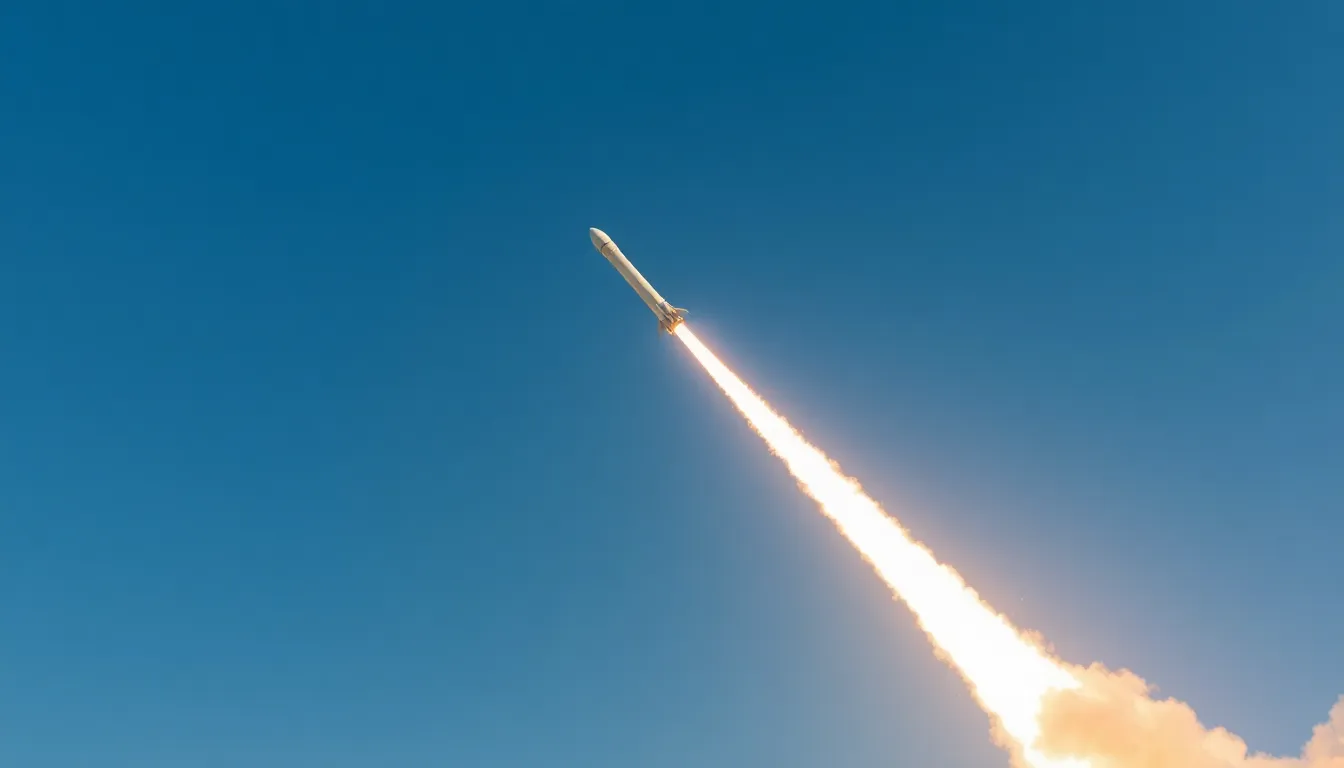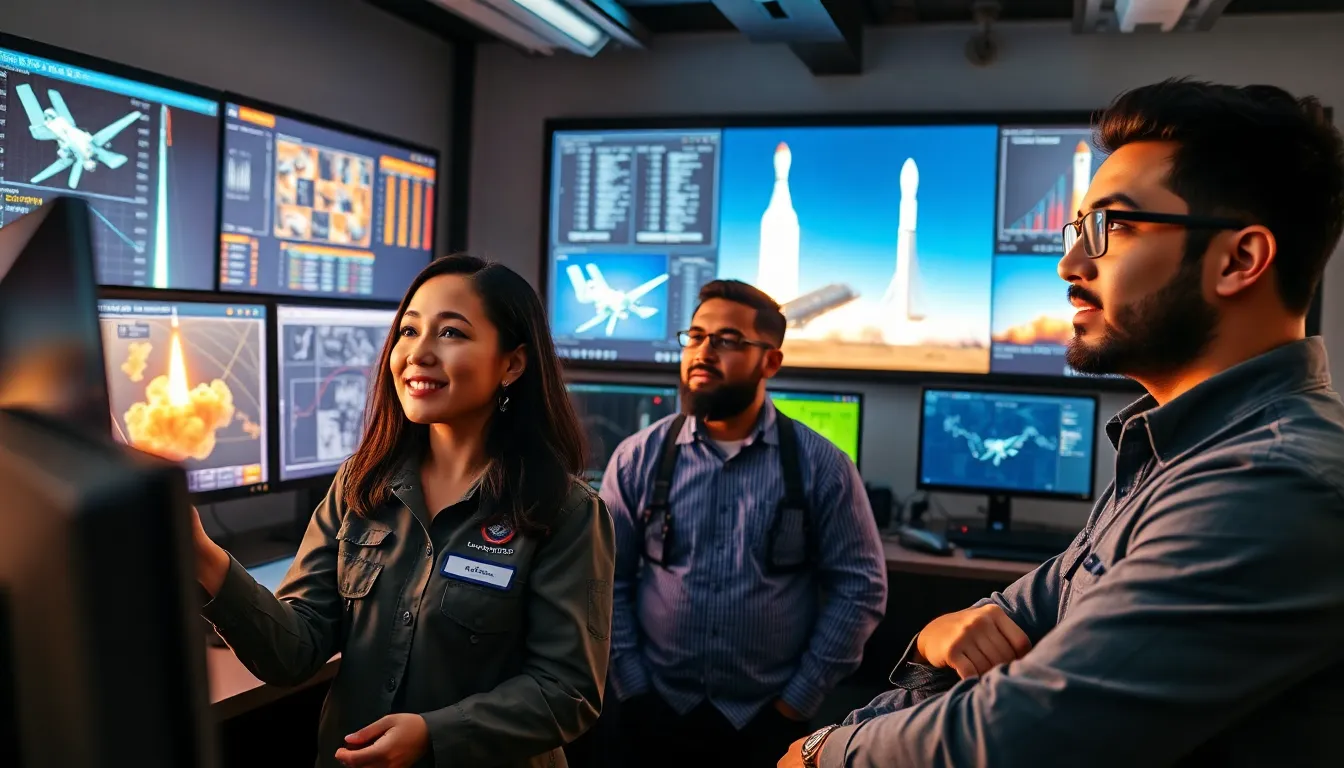Space technology isn’t just for astronauts and sci-fi nerds anymore; it’s woven into the fabric of everyday life. From the GPS guiding your road trips to the satellite dishes that keep you glued to your favorite shows, the wonders of space tech are all around us. Who knew that the same technology that helps launch rockets into orbit also powers your morning coffee routine?
Table of Contents
ToggleOverview of Space Technology
Space technology encompasses various tools, systems, and processes designed for exploration and utilization of outer space. Satellites play a critical role in this field, enabling communication, weather forecasting, and global positioning systems. They orbit Earth and transmit valuable data for everyday applications.
Rockets represent another significant aspect of space technology. They serve as the primary vehicles to transport payloads into space. Their design includes multiple stages to ensure efficient use of fuel and effective payload delivery.
Robotic spacecraft, such as landers and rovers, explore celestial bodies. Rovers like the Mars Curiosity and Perseverance examine Martian terrain, collecting samples and sending back important information. Their autonomous systems make them essential for missions where human presence isn’t feasible.
Advanced materials also contribute to space technology. Lightweight and durable materials, such as carbon fiber composites, enhance spacecraft performance and safety. These innovations stem from aerospace engineering and find applications in various industries on Earth.
Artificial satellites facilitate GPS technology. This positioning system relies on a network of satellites, allowing users to pinpoint locations accurately. Applications range from navigation in vehicles to precision agriculture, showcasing the technology’s versatility.
Telecommunications satellites enable global broadcasting and internet access. They allow seamless communication even in remote areas. Innovations in this domain significantly impact the economy and connectivity.
Earth observation satellites provide crucial data for environmental monitoring. They track changes in climate, land use, and natural disasters. This information aids scientists, governments, and organizations in making informed decisions.
Innovations in propulsion systems, including ion and solar sails, promise future advancements. These technologies aim to improve spacecraft efficiency and enable deeper exploration of the solar system and beyond.
Types of Space Technology Examples

Space technology encompasses various innovations that drive advancements in exploration and everyday applications. The following categories represent key examples.
Launch Vehicles
Launch vehicles transport payloads beyond Earth’s atmosphere. Rockets, such as SpaceX’s Falcon 9 and NASA’s Space Launch System, play critical roles in launching satellites and crewed missions. These vehicles utilize powerful engines that generate thrust to overcome gravity. Engineers design multiple stages within rockets to optimize fuel efficiency. Developing reusable rocket technology significantly reduces launch costs and increases accessibility to space.
Satellite Technology
Satellite technology remains vital for communication, navigation, and Earth observation. Satellites like those in the Global Positioning System (GPS) provide accurate location data worldwide. Telecommunications satellites facilitate global broadcasting and internet services. Earth observation satellites monitor climate change, natural disasters, and urban development. Advancements in miniaturized satellite systems, such as CubeSats, enable cost-effective research and educational opportunities. Enhancements in imaging technology improve data quality for various applications.
Spacecraft Systems
Spacecraft systems encompass various components facilitating safe and efficient space missions. Propulsion systems, including chemical and ion drives, enable spacecraft to traverse vast distances. Life support systems maintain a habitable environment for astronauts during missions. Navigation systems use data from star trackers and gyroscopes to ensure accurate positioning in space. Robotics technology allows for autonomous exploration, as seen in Mars rovers. Ongoing developments in thermal protection systems enhance spacecraft safety during reentry.
Applications of Space Technology
Space technology encompasses various critical applications that influence multiple sectors, enhancing everyday experiences and advancing scientific knowledge.
Communication
Satellites facilitate global communication, enabling reliable telephone and internet services. Telecommunications satellites provide support for broadcasting, enhancing media access worldwide. Innovations in satellite technology, such as high-throughput satellites, improve data transmission speeds. These advancements allow seamless connections across continents and remote areas. Additionally, satellite networks enhance emergency communication during natural disasters, ensuring faster response times.
Earth Observation
Earth observation satellites play an essential role in monitoring environmental changes. They collect data on weather patterns, helping meteorologists issue accurate forecasts. Such satellites facilitate disaster management by providing real-time information on natural events like hurricanes and wildfires. Remote sensing technologies allow researchers to analyze land use changes and track deforestation. Agriculture also benefits from earth observation, aiding in crop monitoring and improving yield predictions based on satellite imagery.
Space Exploration
Space exploration relies on spacecraft to study celestial bodies and gather scientific data. Robotic missions, such as Mars rovers, allow scientists to analyze the surface of other planets. These explorations advance understanding of planetary geology and potential habitats for life. Besides robotic missions, crewed missions depend on advanced spacecraft systems to ensure astronaut safety. Innovations in propulsion technology, like ion propulsion, enable faster travel to distant planets. Such advancements pave the way for deeper exploration of our solar system and beyond.
Future Trends in Space Technology
Innovations in space technology continue to evolve rapidly. Autonomous spacecraft are gaining traction, with advancements in artificial intelligence allowing for complex decision-making during missions. Enhanced data analytics are vital for improving the effectiveness of Earth observation satellites. As a result, environmental monitoring becomes more precise, aiding in disaster response and resource management.
Privatization of space travel is changing the landscape of exploration. Companies like SpaceX and Blue Origin are reducing launch costs and increasing access to space. Competitive launch markets will likely lead to more frequent missions and innovative technologies. Moreover, reusable rocket systems become standard, further decreasing expenses and encouraging commercial ventures.
In propulsion technology, electric propulsion systems are trending. Such systems improve fuel efficiency and extend mission durations, enabling deeper space exploration. Solar sails also promise novel methods of propulsion, relying on sunlight for movement without traditional fuel.
Collaborative international efforts are becoming more prevalent. Partnerships among agencies like NASA, ESA, and ISRO facilitate shared projects and knowledge exchange, enhancing capabilities in both robotic and crewed missions. These collaborations support advancements in planetary research and human spaceflight.
The growing focus on space resource utilization reflects a shift in priorities. Extraction of resources from asteroids and lunar surfaces could provide materials for construction and fuel. Such developments could sustainably support future manned missions to Mars and beyond.
Emerging technologies in satellite design are reshaping capabilities. Miniaturized satellites like CubeSats enable diverse experimental payloads at lower costs. Enhanced communication technologies will improve global connectivity, even in remote areas.
Space technology has transformed countless aspects of everyday life. Its innovations are no longer confined to exploration but have woven themselves into the fabric of daily activities. From navigation to communication and environmental monitoring, these advancements continue to shape how people interact with the world around them.
As the future unfolds, the potential for further breakthroughs in space technology seems limitless. The rise of autonomous spacecraft and advancements in propulsion systems promise to enhance exploration and efficiency. Collaborative efforts among global agencies and private companies are paving the way for more frequent missions and innovative solutions.
With ongoing developments in satellite technology and resource utilization, the impact of space technology will only grow, driving progress on Earth and beyond.




